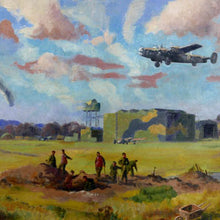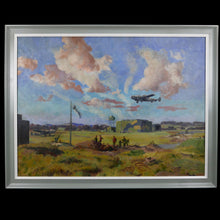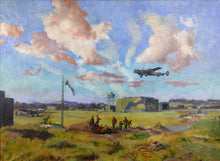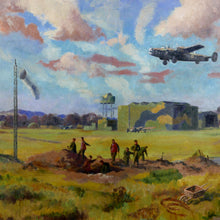A Halifax Squadron Airfield - Stephen Bone, 1942
- Regular price
- £5,800
- Sale price
- £5,800
- Regular price
-
- Unit price
- /per
Adding product to your cart
Overall: 87cm (34.2in) x 112cm (44in)
Oil on canvas. Initialled and dated ‘SB.RR - 42’ for Stephen Bone. Framed
The present painting speaks of the artist’s wartime role as a civilian camouflage officer in the Civil Defence Camouflage Establishment (CDCE) at Leamington Spa prior to his appointment as an Official War Artist attached to the Navy in June 1943. The ‘camoufleurs’ were a body of some 200 artists, a number of whom were professionally and politically affiliated as pre-war members of the Artists International Association (AIA), an anti-war and anti-fascist group of which Bone was a committee member from 1936 to 1939.
In 1942 RAF Bomber Command was expanding rapidly and taking steps to disguise a growing number airfields using techniques devised by the Leamington camoufleurs. These included painting hangars and airfields with disruptive patterns and camouflaging the grass take-off and landing areas by painting fake field boundaries. While these measures might seem obvious today they were at the time Bone painted this scene, high on the agenda of the government’s Committee on Concealment and Deception.
Besides the four-engine Halifax heavy bombers (identifiable as the Mk.II variant with its shorter, square-tipped wings that in 1942 was the mainstay of the night bomber offensive), the grass strip and camouflaged hangars, Bone also documents the tangental activity of airfield construction that was widespread at the time. A 40mm Bofors gun points skyward from its emplacement on the near left, while buried in a gun pit to the near far right the upward barrel of an LMG tells of a paucity of anti-aircraft guns forcing the use of a Bren. Central to the scene is a group of soldiers in battledress and jerkins engaged in earthworks at a short distance from a couple of coils of rusty barbed wire and an unwieldy looking wooden wheelbarrow. The distant hills might suggest one of the Yorkshire airfields that sprung up in 1942 and gave Bomber Command’s 4 and 6 Group sectors the appellation of ‘Halifax Country’.
Read more
Stephen Bone (1904–1958) was born in London, the son of the artist Sir Muirhead Bone (1876-1953). Educated at Bedales School, he studied at the Slade from 1922 to 1924 under Henry Tonks, and in 1925 won a gold medal for wood engraving at the International Exhibition in Paris. In 1929 he married the painter Mary Adshead (1904-95), who had been a fellow student at the Slade School. They travelled extensively in Greece, Italy and the British Isles. From 1920 Bone exhibited with the New English Art Club, becoming a member in 1932. He exhibited widely in the 1930s, showing landscapes and portraits with the Royal Academy, the Fine Art Society, and in Stockholm, Sweden in 1936 and 1937. His wartime work for the WAAC included a wide variety of scenes in Scotland and the Scottish Isles, and scenes on board air-sea rescue craft, submarines, minesweepers, aircraft carriers. Bone was sent to document the Normandy beach landings in 1944 and in 1945 to Norway to paint the wreck of the Tirpitz as well as captured naval bases and German prisoner of war camps. After the war he became art critic to the Manchester Guardian and in the 1950s was a regular TV and radio broadcaster.








